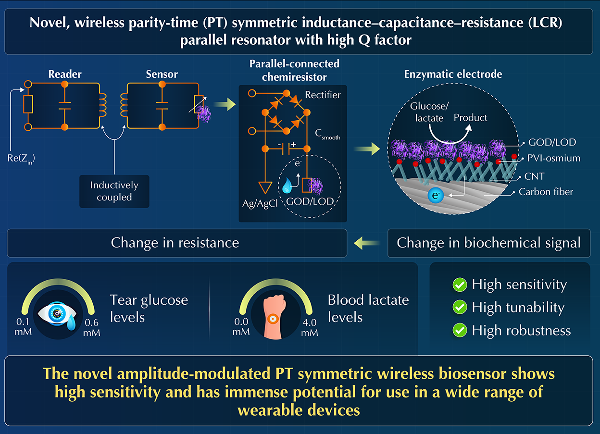Researchers develop highly sensitive biosensors
- April 18, 2023
- William Payne

Researchers from Japan have developed a new wearable biosensor that can detect extremely small changes in tear glucose and blood lactate levels. The biosensor, developed at Tokyo’s Waseda University, has the potential to transform personalised health monitoring by providing far more sensitive, robust and configurable wearable biosensors compared to the chipless resonant antenna sensors used in today’s medical wearables.
Current chipless resonant antennae are highly promising components of wearable biosensors, as they are affordable and easy to control. However, their practical applications are limited by their low sensitivity to biomarkers.
To overcome this hurdle, researchers led by Professor Takeo Miyake from Waseda University, Professor Yin Sijie from Beijing Institute of Technology, and Taiki Takamatsu from Japan Aerospace Exploration Agency, have developed a wireless bioresonator using “parity–time (PT) symmetry” that can detect minute biological signals. Their work has been published in Advanced Materials Technologies.
In their research, the scientists designed a bioresonator comprising a magnetically coupled reader and sensor with increased sensitivity to biochemical changes.
The reader and sensor both comprise an inductor (L) and capacitor (C) that are parallel-connected to a resistor (R). In the sensor, the resistor is a chemical sensor called a “chemiresistor” that converts biochemical signals into changes in resistance. The chemiresistor contains an enzymatic electrode with an immobilised enzyme. Minute biochemical changes at the enzymatic electrode (in response to changes in the levels of biomolecules such as blood sugar or lactate) are thus converted into electrical signals by the sensor, and then amplified at the reader.
Professor Miyake said: “We modelled the characteristics of the PT-symmetric wireless sensing system by using an eigenvalue solution and input impedance, and experimentally demonstrated the sensitivity enhancement at/near the exceptional point by using parallel inductance–capacitance–resistance (LCR) resonators. The developed amplitude modulation-based PT-symmetric bioresonator can detect small biological signals that have been difficult to measure wirelessly until now. Moreover, our PT-symmetric system provides two types of readout modes: threshold-based switching and enhanced linear detection. Different readout modes can be used for different sensing ranges.”
The researchers tested the system on human tear fluids and found that it could detect glucose concentrations ranging from 0.1 to 0.6 mM. They also tested it with a lactate-specific enzyme and commercially available human skin and found that it could measure lactate levels in the range of 0.0 to 4.0 mM through human skin tissue, without any loss of sensitivity. This result further indicates that the biosensor can be used as an implantable device. Compared to a conventional chipless resonant antenna-based system, the PT-symmetric system achieved a 2000-fold higher sensitivity in linear and a 78% relative change in threshold-based detection respectively.
Professor Miyake said: “The present telemetry system is robust and tunable. It can enhance the sensitivity of sensors to small biological signals. We envision that this technology can be used for developing smart contact lenses to detect tear glucose and/or implantable medical devices to detect lactate for efficient monitoring of diabetes and blood poisoning.”





